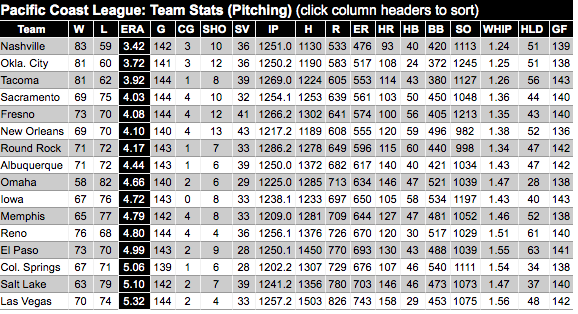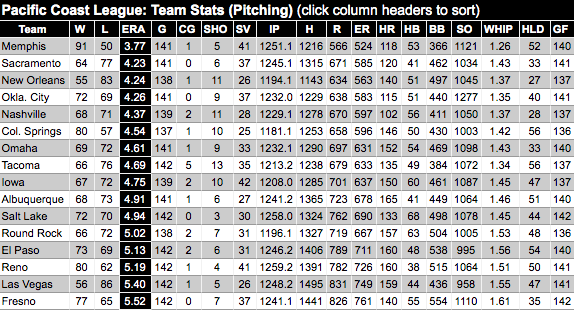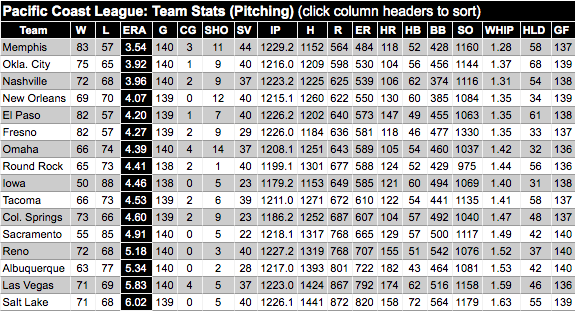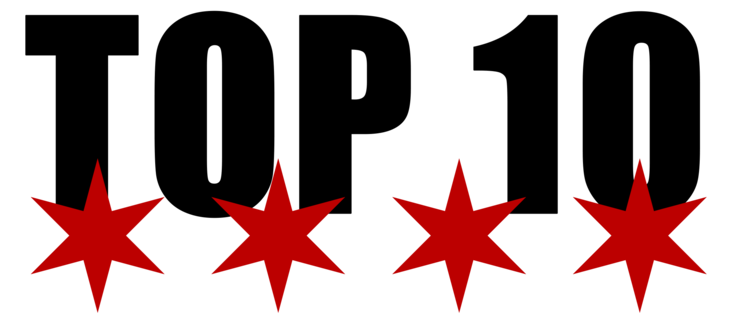When Major League Baseball made the request last summer to begin using Major League balls, the switch was an attempt to bring uniformity to the highest level of the league’s farm systems. It made sense, considering the amount of taxi squad players who jump up and down from the big club during the season. But, now, as the Triple-A season shifts into summer, the results have been eye-popping — team ERA’s have skyrocketed thanks to what many are call “juiced balls.”
The concerns, especially from Triple-A pitchers, are valid. While Major League Baseball might be happy to see juiced ball numbers in the post-steroid era, the arms delivering the record number of home runs and offensive output are most definitely not. In fact, this season has seen an offensive explosion in the Pacific Coast League — which is home to the Iowa Cubs and Las Vegas Aviators — as well as the International League, where the Charlotte Knights play.
The long ball sells tickets, but — as young pitchers develop — they are finding a hard time adjusting to the limits the balls have on spin rate and offspeed command. More troublesome is how much of a difference changing to the balls is making, proving that Major League Baseball is juicing their balls in an attempt to dull down pitching, and elevate more offensive production in an era of declining ratings.
There’s already been talk of moving the mound back to 62 feet, six inches, as well as lowering the mound from its current 10-inch height. Add into the equation this “where-there’s-smoke-there’s-fire” proof the balls in “The Show” are loaded, it seems obvious the powers-that-be are attempting to undermine today’s modern pitchers.
“I’d be fine with the balls going further if they didn’t mess with my pitches,” one current minor leaguer in the PCL texted me this morning. “But when the new balls f*ck with me throwing good splitters, I’m f*cked.”
Mind Over Matter: Pitchers Mind and It Matters
Pitchers are seeing it. They’re feeling it. They’re having hard time adjusting to it.
“I can’t speak factually that the ball is why it’s happening, as far as the increased home run numbers, but I know that hitters mentally think there’s a big difference and pitchers think it’s a big difference and the mind’s a pretty powerful thing,” Las Vegas Aviators manager Fran Riordan said. “So, whether it’s a little mental and a little physical, I think you could argue both.”
2016


2017


2018


2019 (to date)


Aviators pitching coach Rick Rodriguez feels it’s better for development in the long run.
“Overall, they’re happy to be using the major league baseballs,” Rodriguez said. “They’ve always voiced their opinion. ‘Why can’t Triple-A be like the big leagues and have the same ball, because it’s a little bit of an adjustment when you go up there?’ So, that’s one aspect they don’t have to worry about, the baseball.
“You get to the major leagues, and it’s the same. The guys here have the physical ability to pitch in the major leagues. Your stuff is your stuff. It’s more about being consistent — getting ahead in the count, being able to put hitters away with your pitch, so when you go up to the big leagues, you’ve already rehearsed all that.”
While the better pitchers will always find a way to adapt and adjust to the game — and the balls — the way pitchers did in 1968, when the mound was lowered to its current height of 10 inches from a whopping 15 inches high, it isn’t making life easy on the farm.
The reason for MLB’s change in 1968? Baseball was in an offensive crisis. Seven teams hit .230 or lower, including the Yankees, who batted .214 as a team. The big league average ERA that season was 2.98, which is more than a run lower than the recent 2018 season (4.15) and 2019’s current 4.30 ERA. Teams combined to score 6.8 runs per game in 1968 as opposed to last year, when they scored 8.8 per game.
All in all, the game itself has seen its league ERA rise from 3.74 in 2014 to its current average. But, still, Major League Baseball wants to load up the die for the hitters even more, even at Triple-A? The league cites the fact that there were more strikeouts than hits in 2018 for the first time in Major League Baseball’s 147-year history as its excuse but it fails to realize this is more a byproduct of the current “lift-and-pull, launch angle, exit velocity” philosophy prevalent in baseball today.
Current hitters (former Cubs hitting coach Chili Davis aside) care nothing about striking out because “an out is an out.” In fact, some prefer it to rolling into a double play ball, or getting cheated. Home runs are at a record high and run support isn’t suffering when the bases clear thanks to the long ball.
Rotational swing, linear, none of these really even matter anymore in a game where the use of sabermetrics by so many discourage situational hitting, manufacturing runs, and other nuances like bunting and stealing bags. While strikeouts are up this year, other than two years ago, the league is scoring more runs per game this season than it has since 2009.
The league is failing to realize it’s the approach — not the actual dimensions or baseball — that has resulted in this drop in average.
Whatever the purpose, whatever the reason, a Modern “Juiced Ball Era” is upon us once again but, this time, it’s powered by league adjustments and rule changes, not steroids and rampant PED abuse, and it’s filtered down to the next level.
According to Baseball America, “Last April, Triple-A hitters homered once every 47 plate appearances. As the weather warmed up, so did the home run rate. Over the course of the entire 2018 season, Triple-A hitters homered every 43 plate appearances. So far this year, they are homering every 32 plate appearances. Triple-A hitters are hitting home runs at a rate of 135 percent of last year’s rate.”
This time, the effect has not only permeated the big leagues, it’s also giving minor league pitchers fits as well. Still, it does prepare the Triple-A arms for what they’ll be forced to adjust to sooner or later, which is never a bad thing.
“That change in ball is a little more of an issue than people realize,” said St. Louis lefty reliever Tyler Webb. “Now, it’s one ball, both ways, so it’s one less thing you can kind of eliminate from going up from Triple-A to the big leagues, which is ultimately a good thing. It might go a little farther down there — especially in the PCL — but it’s a good tradeoff to know what that ball’s going to do when you get called up.”












